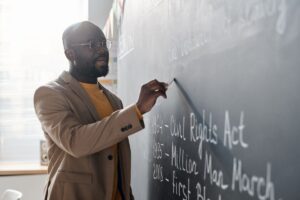What does a school principal do? The range of answers to this question would vary greatly from what students, staff, and the community might say, but this high school principal in his seventh year in that role will try to break this down in a way that even I could understand the three-ring circus that occurs each day.
In our defense, it is not as crazy as a three-ring circus, but the analogy of three major arenas is worth discussing, and management of these components is the key. The three areas that almost everything falls into are operations, academics, and culture.
Operations
Mazlov’s Hierarchy of Needs applies directly to a school’s function, thus why operations and how a school functions leads off our three-ring Venn diagram. Before any learning can occur, distractions that can take away from learning must be minimized, and the people in the building need to be taken care of.
This begins and ends with the safety of the faculty and students in the building.
Any kind of perception or actual threat in or outside of the building will make teaching and learning difficult. The following question must be answered positively: Do our staff and students feel safe in the building? Principals must keep safety and security at the foremost something to be monitored.
Discipline will fall into this category and serve as an example of how some items span all three arenas. How well supported the teachers and even students feel when other students do clearly wrong things will impact the ease of learning. Quick, fair, and reasonable discipline will help run a school smoothly.
Another operation in the Mazlov’s hierarchy that must be monitored and the principal needs to attend to are the food service operations. Too many of our students today rely on the school as the most reliable place for two meals a day. Without this, many of our students will be hungry to learn their next timetable or write their next essay. This is a way that schools and administrators are meeting the needs of students.
Next is the simple cleanliness and temperature of the building. It distracts learning when rooms are not clean, and trash gets in the way. When the building is not cool enough or warm enough, it is a distraction that concentration in the classroom comes easy. Sometimes, the allergens in the air system can cause sickness or breathing issues. All of these things need to be running well and checked by the principal with the help of maintenance.
Three other operations that need to run well are pick-ups, dismissals, and the schedule for the day. Nothing can impact the community opinion of school more than how smoothly or inefficiently dropping off students and picking up students can be. Then nothing can impact staff more than how smoothly the transitions and switches will take place in the building. A principal has to make sure these operations are running smoothly.
Academics
The foundation (operations) have been laid, now let’s start building the house with the principal as the instructional leader of the school.
The master schedule of the school is the number one academic matrix that a principal will deal with. Who teaches what, when, where, and how are we addressing our most pressing needs are all things that the master schedule will address. From here the principal gets to set up their strategic plan for the entire school. This will impact how the schools budget is spent.
The next academic aspect that the principal monitors is the actual academic progress of the school. This involves how data is being tracked toward student success and the school’s goals. This includes progress on state-mandated targets and a school’s own initiatives. Another critical aspect of this is the actual teaching and learning in the classroom. The evaluation and progress of staff in the art of teaching has to be one of the top priorities of a principal. A rising tide raises all ships, thus if there is improvement in those who are teaching, more student success can’t be far behind.
Another aspect that leads into teaching in the classroom is the support given to teachers.
This spans from technology in the classroom, to assisting in the accommodation needed for some students, etc. Is taking attendance easy, can showing a PowerPoint to students happen without distractions, is the internet running smoothly, and is there someone available to help read tests to students? All of these are examples of how the academic infrastructure needs to be monitored and, at times, addressed by the principal.
Culture
With the academics and operational foundation in place, the principal must make the building one where staff and students want to come daily.
How are relationships from teacher to teacher? Is there good professional collaboration taking place between staff so they are improving their craft? Is the principal providing time for staff to get to know each other personally and for relationships to grow. If relationships grow at the staff level, they will carry over from staff to students. A faculty that wants to teach, will lead to students who want to learn. How a principal addresses morale (the desire to charge the hill) will directly impact student success.
Another major aspect of culture that a principal needs to directly impact is how welcoming the community feels when they come to school. When someone walks in, how welcoming is the atmosphere? Do parents and guardians feel as if the school is an advocate or adversary for their student? This can range from the type of events held on campus to the frequency of events.
Lastly, especially in higher grade levels, how a principal encourages and supports students in extracurricular activities can impact the culture of a campus. Many secondary students academics take a back seat (no, it should not) to their extracurricular activities, but either way, it still brings them to school; that is the most important thing!
So, what does a principal do? It is a tightrope of items to focus on from making sure the campus is a place where learning can take place to making sure learning is taking place to making sure the school is a place where stakeholders want to come and learn every day. Some days, operations will be the focus. Some days, academics will be the focus, and some days all three items will be addressed multiple times. Balancing this three-ring circus is the primary thing that principals do every day.
A graduate degree in administration prepares you to lead as a principal, superintendent or other school administrator and help shape the future for generations of students. Check out our available leadership and administration graduate degrees and get started today!




